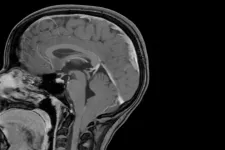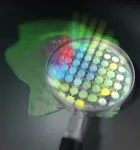(Press-News.org) People with certain genetic conditions are likely to have significant symptoms of autism, even if they do not meet all diagnostic criteria, a study concludes.
Researchers at Cardiff University say their findings show clinical services need to adapt so that people diagnosed with autism-linked genetic conditions are not denied access to vital support and interventions.
Published in The American Journal of Psychiatry, the international study analysed data from 547 people who had been diagnosed with one of four genetic conditions, also known as copy number variants (CNVs), associated with a high chance of autism - 22q11.2 deletion, 22q11.2 duplication, 16p11.2 deletion and 16p11.2 duplication.
CNVs happen when a small section of a person's DNA is missing or duplicated. Certain CNVs have been linked to a range of health and developmental issues. They can be inherited but can also occur at random.
The results showed a high prevalence of autism in individuals with these four genetic conditions, ranging from 23% to 58%. The prevalence of autism in the general population is 1%.
Using clinical cut-offs, the team also found 54% of people with these genetic conditions who did not meet full autism diagnostic criteria nonetheless had elevated levels of autistic symptoms. There was also considerable variability in symptoms of autism between those who had the same genetic condition.
Dr Samuel Chawner, based at Cardiff University's MRC Centre for Neuropsychiatric Genetics and Genomics said: "Our study shows that an individualised approach is needed when assessing the needs of people with genetic conditions. Although many of those who were included in this study would not have met all of the criteria which define someone as having autism, more than half of those with these genetic conditions had significant symptoms associated with it - such as social and communication difficulties or repetitive behaviours.
"There is a danger that being too prescriptive with how autism is diagnosed will result in these individuals slipping through the net and being denied important services. Sadly, many families we have met through doing this research describe longstanding struggles in accessing autism support for their child. This is often due to a lack of integration between genetic testing services and autism diagnosis services.
"Low awareness of genetic conditions can also be a barrier. It is important that clinicians are aware of the risk of autism associated with certain genetic conditions in order to improve opportunities for early diagnosis and support."
Data for the study was pooled from eight clinical research centres around the world, which had used the "Autism Diagnostic Interview - Revised (ADI-R)" and IQ tests on study participants.
The ADI-R is used internationally in research as well as in clinical settings for making autism diagnoses. It involves an interview with the parent or guardian and asks about the child's developmental history across areas of social skills, communication skills and repetitive behaviours.
It is estimated that 15% of autistic people and 60% of people with developmental delay have a genetic condition.
Helen Hyde's 16-year-old daughter, Hermione, was diagnosed with 22q.11.2 Deletion when she was four. Her genetic diagnosis first came to light after it was found she had a cleft palate, which affects her speech. She has Developmental Verbal Dyspraxia (DVD), which causes difficulties with how she processes and communicates language. As a consequence Mini attends a school for pupils with language disorders where she is fully supported in her education. She has also been diagnosed with comorbid anxiety.
Mini, as she's known to her family, wasn't formally diagnosed with autism until last year, even though researchers at Cardiff University and her school had previously flagged that she had autistic traits. The family have been involved in studies with Cardiff University's Copy Number Variant research group for eight years.
"In many ways, the physical diagnosis of Mini's cleft palate has been easier to deal with than the autism and mental health issues," said Helen, also mum to Olivia, 19 and Edward, 23.
"People have less of an understanding of Mini's autistic traits and it's been much harder to get the right support for her.
"That's why Cardiff University's research in this area is so vital. It's giving us the tools to be able to fight Mini's corner so that she fulfils her potential."
Mini said: "At first I did not know what 22q was but now I understand more. My main problem is my speech. Sometimes people don't understand me and that can make me cross. Sometimes I find lessons difficult and I need a lot of help at school. I know they can learn lots of things from these studies and this will help people with 22q in the future."
Tracy Elliot, Head of Research and Information at charity Cerebra, said: "We know many children and families frequently have problems in accessing autism support services or face very long delays. We welcome the findings of this research that indicate that individuals with different genetic conditions could benefit from the same autism support. This reinforces the case for improved support and should ease the path for parents and children with rare conditions."
INFORMATION:
Cardiff University is an international leader of research on genetics and neurodevelopmental conditions and has developed one of the largest research cohorts of individuals with neurodevelopmental genetic conditions in the world.
https://ajp.psychiatryonline.org/doi/10.1176/appi.ajp.2020.20010015
ADELPHI, Md. -- Multi-domain operations, the Army's future operating concept, requires autonomous agents with learning components to operate alongside the warfighter. New Army research reduces the unpredictability of current training reinforcement learning policies so that they are more practically applicable to physical systems, especially ground robots.
These learning components will permit autonomous agents to reason and adapt to changing battlefield conditions, said Army researcher Dr. Alec Koppel from the U.S. Army Combat Capabilities Development Command, ...
Gallium is a highly useful element that has accompanied the advancement of human civilization throughout the 20th century. Gallium is designated as a technologically critical element, as it is essential for the fabrication of semiconductors and transistors. Notably, gallium nitride and related compounds allowed for the discovery of the blue LED, which was the final key in the development of an energy-efficient and long-lasting white LED lighting system. This discovery has led to the awarding of the 2014 Nobel Prize in Physics. It is estimated that up to 98% of the demand for gallium originates from the semiconductor ...
About one in 100 children has a common brain disorder called Chiari 1 malformation, but most of the time such children grow up normally and no one suspects a problem. But in about one in 10 of those children, the condition causes headaches, neck pain, hearing, vision and balance disturbances, or other neurological symptoms.
In some cases, the disorder may run in families, but scientists have understood little about the genetic alterations that contribute to the condition. In new research, scientists at Washington University School of Medicine in St. Louis have shown that Chiari 1 malformation can be caused by variations ...
Use of the delivery system in mouse models results in unprecedented siRNA penetration across the intact blood brain barrier
Technology could offer potential for a variety of human neurological disorders
In the past few decades, researchers have identified biological pathways leading to neurodegenerative diseases and developed promising molecular agents to target them. However, the translation of these findings into clinically approved treatments has progressed at a much slower rate, in part because ...
Fluorescence microscopy is widely used in biochemistry and life sciences because it allows scientists to directly observe cells and certain compounds in and around them. Fluorescent molecules absorb light within a specific wavelength range and then re-emit it at the longer wavelength range. However, the major limitation of conventional fluorescence microscopy techniques is that the results are very difficult to evaluate quantitatively; fluorescence intensity is significantly affected by both experimental conditions and the concentration of the fluorescent substance. Now, a new study by scientists from Japan is set to revolutionize the field of fluorescence lifetime ...
LOS ANGELES (Dec. 30, 2020) -- People who move due to unaffordable housing are at increased risk of failing to receive the medical care they need, according to a new study from Cedars-Sinai and the University of California, Los Angeles. The study, published online in the Journal of General Internal Medicine, concludes that the result could be long-term health problems.
The findings were based on 146,417 adults who responded from 2011 to 2017 to the California Health Interview Survey, the largest such state survey in the U.S. ...
One of the physiopathological characteristics of COVID-19 that has most baffled the scientific and medical community is what is known as "silent hypoxemia" or "happy hypoxia". Patients suffering this phenomenon, the causes of which are still unknown, have severe pneumonia with markedly decreased arterial blood oxygen levels (known as hypoxemia). However, they do not report dyspnea (subjective feeling of shortness of breath) or increased breathing rates, which are usually characteristic symptoms of people with hypoxemia from pneumonia or any other cause.
Patients with "silent hypoxemia" often suffer ...
BOSTON -- Pregnant women may be especially vulnerable to developing more severe cases of COVID-19 following SARS-CoV-2 infection, but little is known about their anti-SARS-CoV-2 immune response or how it may affect their offspring. In a study published in JAMA Network Open, a group led by investigators at Massachusetts General Hospital (MGH) provides new insights that could help improve care for these women and their newborns and emphasizes the need for pregnant women to be considered in vaccine rollout plans.
The study included 127 pregnant women in their third trimester who received care at three Boston hospitals between April 2 and June 13, ...
Pregnant women who are infected with SARS-CoV-2, the virus that causes COVID-19, during the third trimester are unlikely to pass the infection to their newborns, suggests a study funded by the National Institutes of Health. The study followed 127 pregnant women who were admitted to Boston hospitals during the spring of 2020. Among the 64 pregnant women who tested positive for SARS-CoV-2, no newborns tested positive for the virus. NIH support was provided by the Eunice Kennedy Shriver National Institute of Child Health and Human Development (NICHD), the National Heart, Lung, and Blood Institute (NHLBI), and the National Institute of Allergy and Infectious ...
Surgery, in addition to treatments like chemotherapy and radiation therapy, may increase the length of survival for metastatic breast cancer patients, according to Penn State College of Medicine and Penn State Cancer Institute researchers. They studied nearly 13,000 stage four breast cancer patients and found that those who had surgery in addition to their other treatments had a survival advantage over those who had other treatments alone.
Stage four breast cancer accounts for 6% of newly diagnosed breast cancer cases. Systemic therapy, which may include treatments like chemotherapy, hormone therapies and immunotherapies, ...



